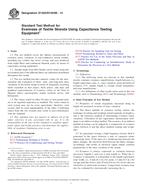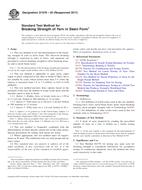We need your consent to use the individual data so that you can see information about your interests, among other things. Click "OK" to give your consent.
ASTM D1425/D1425M-14
Standard Test Method for Evenness of Textile Strands Using Capacitance Testing Equipment
STANDARD published on 1.7.2014
The information about the standard:
Designation standards: ASTM D1425/D1425M-14
Note: WITHDRAWN
Publication date standards: 1.7.2014
SKU: NS-17250
The number of pages: 5
Approximate weight : 15 g (0.03 lbs)
Country: American technical standard
Category: Technical standards ASTM
The category - similar standards:
Annotation of standard text ASTM D1425/D1425M-14 :
Keywords:
strand, textile, evenness, yarn, ICS Number Code 59.080.50 (Ropes)
Additional information
| Significance and Use | ||||||||||||
|
6.1 This test method for the determination of evenness of textile strands is used extensively for acceptance testing of commercial shipments of filament or spun staple yarn, comber laps, roving, sliver, or tops. 6.2 Values of strand evenness are also used in quality control, process optimization, and together with yarn strength measurements, as the first appraisal of a strand's quality. A low evenness value is, in general, preferred. Higher evenness values generally indicate poor yarn manufacturing practices, lower yarn strength, and poorer fabric appearance. Experience has shown that the relationship of evenness to the prediction of yarn performance and to fabric appearance is not a simple one. An evenness value must, therefore, be used cautiously and be supplemented by additional evenness information, such as mid-term and long-term mass variations, thin, thick, and nep imperfection counts, diagram chart spectrogram chart, length variation curve, and histogram analyses. 6.3 Continuous filament yarns should be tested for mass variation on evenness testers that are specifically designed to test this yarn type; failure to do so will result in inaccurate test results. Further, low-twist, continuous filament yarns tend to flatten to a ribbon configuration while passing through the sensor of a capacitance instrument. This flattening effect will cause false mass variation measurements by the capacitive sensor (commonly referred to as shape effect). Evenness testers that are specifically designed to test continuous filament yarns insert a false twist to the yarn strand during testing to overcome the flattening effect and thus ensure accurate mass variation measurements. 6.4 Strands made from fiber blends should be tested only if the different fibers are uniformly distributed throughout the strand. Non-uniform blending may cause a higher reading of mass variation than the true value if the component fibers differ in dielectric constant. 6.5 Evenness values obtained on different instruments will be comparable for strands from the same sample provided the following parameters are the same in all cases: (1) the measure of evenness used (CV% or U%); (2) the capacitive length zone 6.6 If there are any differences of practical significance between reported test results for two (or more) laboratories, comparative tests should be performed using an agreed upon number of samples that are homogeneous and randomly assigned. Competent statistical assistance should be used to determine if there is a statistically significant difference between the laboratories. If a bias is found, either its cause must be found and corrected, or future testing for that material must be adjusted in consideration of the statistically significant differences found. |
||||||||||||
| 1. Scope | ||||||||||||
|
1.1 This test method covers the indirect measurement of evenness (mass variation) of non-conductive textile strands, including top, comber lap, sliver, roving, and yarn produced from staple fibers and continuous filament yarns, by means of capacitance testing equipment. 1.2 Strands made from fiber blends can be tested using this test method only if the different fibers are uniformly distributed throughout the strand. 1.3 The test method provides numeric values for the measurement and evaluation of short-, mid-, and long-term mass variations of the tested strand in terms of frequently occurring faults classified as thin places, thick places, and neps and graphical representations of evenness values in the form of diagram charts, spectrograms, length variation curves, and histograms. 1.4 The values stated in either SI units or inch-pound units are to be regarded separately as standard. The values stated in each system may not be exact equivalents; therefore, each system shall be used independently of the other. Combining values from the two systems may result in non-conformance with the standard. 1.5 This standard does not purport to address all of the safety concerns, if any, associated with its use. It is the responsibility of the user of this standard to establish appropriate safety and health practices and determine the applicability of regulatory limitations prior to use. |
||||||||||||
| 2. Referenced Documents | ||||||||||||
|
Similar standards:
Historical
1.5.2011
Historical
1.1.2011
Historical
1.7.2012
Historical
1.6.2007
We recommend:
Technical standards updating
Do you want to make sure you use only the valid technical standards?
We can offer you a solution which will provide you a monthly overview concerning the updating of standards which you use.
Would you like to know more? Look at this page.



 ASTM D1578-93(2011)..
ASTM D1578-93(2011).. ASTM D4974-04(2011)..
ASTM D4974-04(2011).. ASTM F1740-96(2012)..
ASTM F1740-96(2012).. ASTM F2116-01(2007)..
ASTM F2116-01(2007)..
 Cookies
Cookies
